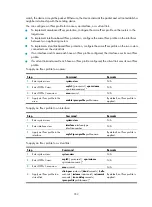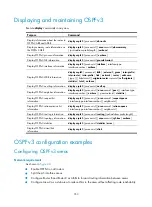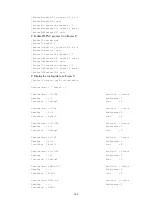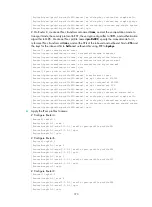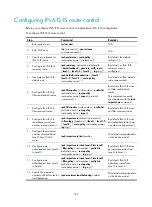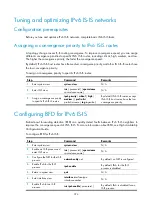
359
[RouterD] interface ethernet 1/1
[RouterD-Ethernet1/1] ospfv3 1 area 0
[RouterD-Ethernet1/1] quit
# Display neighbors on Router A. The routers have the same default router priority 1, so Router D
(the router with the highest Router ID) is elected as the DR, and Router C is the BDR.
[RouterA] display ospfv3 peer
OSPFv3 Process 1 with Router ID 1.1.1.1
Area: 0.0.0.0
-------------------------------------------------------------------------
Router ID Pri State Dead-Time Interface Inst ID
2.2.2.2 1 2-Way/DROther 00:00:36 Eth1/1 0
3.3.3.3 1 Full/Backup 00:00:35 Eth1/1 0
4.4.4.4 1 Full/DR 00:00:33 Eth1/1 0
# Display neighbors on Router D. The neighbor states are all full.
[RouterD] display ospfv3 peer
OSPFv3 Process 1 with Router ID 4.4.4.4
Area: 0.0.0.0
-------------------------------------------------------------------------
Router ID Pri State Dead-Time Interface Inst ID
1.1.1.1 1 Full/DROther 00:00:30 Eth1/1 0
2.2.2.2 1 Full/DROther 00:00:37 Eth1/1 0
3.3.3.3 1 Full/Backup 00:00:31 Eth1/1 0
3.
Configure router priorities for interfaces:
# Specify the router priority for the interface Ethernet 1/1 of Router A as 100.
[RouterA] interface ethernet 1/1
[RouterA-Ethernet1/1] ospfv3 dr-priority 100
[RouterA-Ethernet1/1] quit
# Specify the router priority for the interface Ethernet 1/1 of Router B as 0.
[RouterB] interface ethernet 1/1
[RouterB-Ethernet1/1] ospfv3 dr-priority 0
[RouterB-Ethernet1/1] quit
# Specify the router priority for the interface Ethernet 1/1 of Router c as 2.
[RouterC] interface ethernet 1/1
[RouterC-Ethernet1/1] ospfv3 dr-priority 2
[RouterC-Ethernet1/1] quit
# Display neighbors on Router A. The output shows that the router priorities have been changed,
but the DR and BDR are not changed.
[RouterA] display ospfv3 peer
OSPFv3 Process 1 with Router ID 1.1.1.1
Area: 0.0.0.0
-------------------------------------------------------------------------








